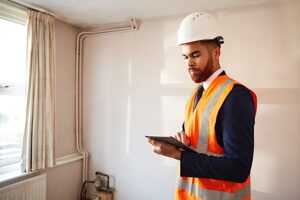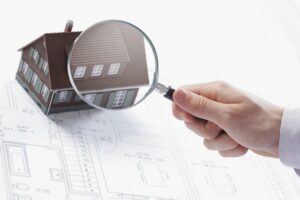Professional Home Inspection Checklist
You’ve made an offer on a home, your offer was accepted, and now you’re in escrow waiting for inspection day. How will you succeed? By crossing items off our thorough home inspection checklist. With a home inspection checklist by your side, you’ll move into the home of your dreams in no time.
Buying your first home is accompanied by a myriad of emotions. You’re excited because you finally have a place to call your own. You’re nervous to look at your savings account after paying a down payment. You’re exhausted after spending months working with an agent to find the perfect home.
Don’t worry, this rollercoaster of feelings is completely natural and will come to an end soon. The hardest steps are out of the way when all that’s left is an inspection and final walkthrough. And because the inspection process can be demanding, we’ve created an ultimate home inspection checklist to ease your fears and help transition you into the home of your dreams.
What Is A Home Inspection
A home inspection is an examination of a newly purchased property for any potential issues. The process is typically conducted by a professional inspector, who will then provide a full status report on the home. The purpose of a home inspection is to reveal any problem areas before the end of the closing process. This provides both buyer and seller a chance to renegotiate or even walk away from the transaction if necessary.
While it may sound scary, a home inspection is actually one of the best safeguards put in place for homebuyers. In many cases, home inspections do not reveal any surprises at all. But, when they do buyers can communicate with the sellers about a potential fix. Any fixes that are made can be checked over in the final walkthrough. It is absolutely crucial to get a home inspection, even if you have a great feeling about the property. The home inspection process can protect you, and your wallet, from a number of unexpected surprises in the future.

Home Inspection: What to Expect and What to Inspect
Inspection day is often one of the most exciting moments of home buying because it’s likely the first chance you have to go inside the home since you made your offer. It’s also usually the last chance you’ll have until a final walkthrough. But more importantly, it’s your opportunity to make sure you know what you’re getting yourself into when it comes to the condition of the home.
Home inspections don’t just provide you with a list of problems you want to negotiate with the seller to fix or something catastrophic that makes you back out of the deal altogether. It will provide you a detailed report that is something of a “new owner’s manual” for the home. It will include maintenance tips and schedules you should follow.
Finding an inspector
You should hire a licensed, professional inspector to conduct a thorough inspection. How do you choose one? Along with agents, lenders and other home pros, Zillow has lists of inspectors with reviews. You can use the Agent Finder tool to find all kinds of real estate pros, including inspectors. Get recommendations, check their online reviews and study their websites. Get a sample report to make sure what they will produce is thorough. Your agent probably has suggestions but you don’t need to use them.
You will want to be clear on exactly what is and isn’t included in the inspection price. Will they test for lead paint? How about asbestos in the ceiling tiles? Is that part of the basic inspection or will it cost more? The price, though you will pay it, is probably the least of your concerns. Most inspectors are in a similar range of $300-$500 anyway and any fluctuation is a small price to pay for what you will get. Early in the home buying process start researching inspectors and have at least a couple in mind, especially if the market is busy. You’ll need to be sure you can get an inspection scheduled within your contract timeline, so if your first choice isn’t available, you need someone waiting in the wings.
Inspection day
You should plan on being there and your agent should be right there with you the entire time. Chances are the seller’s agent will be there, too to help get any quick answers the inspector might need. Block off the entire morning or afternoon. Home inspections take time and you don’t want to rush through it. During this time, follow along as much as you can. You don’t have to follow the inspector into the crawlspace – they bring protective clothing just for that – but anyplace reasonably accessible, you should go too.

A BUYER’S GUIDE TO HOME INSPECTION
homebuyers should skip. Foregoing the home inspection could cost buyers lots of money later. You wouldn’t want to buy a $300,000 house and later discover a huge defect that will cost thousands of dollars to repair. A home inspection is like the doctor’s checkup you get covering major systems and diagnosing problems. Many states require sellers to provide buyers with property condition disclosure forms, but it’s a good idea to hire an independent home inspector.
HOME INSPECTION BASICS
A home inspection is a detailed report prepared by a home inspector about the condition of home systems, deterioration, and recommendations. The inspection could take between 2 and 5 hours and may cost between $250 and $500. Many buyers attend home inspections so they can better understand the issues, ask questions, and learn more about the house and its major systems.
THE WHY OF HOME INSPECTIONS
Buyers often order home inspections to ensure the major systems are in good condition and that there are no serious, expensive defects. Sellers might order a pre-listing inspection to identify major problems that need to be fixed before the house is put on the market. Common in most sales contracts, a home inspection contingency makes a sales conditional upon the outcome of the home inspection report. A home inspection is also a good way to identify repairs to request and to learn about the elements and systems of a house.
ELEMENTS OF A HOME INSPECTION
The home inspector will examine major elements of a house, ensuring proper operation of systems, observing the condition, and noting damage. A typical home inspection report will cover:
The exterior: Roof, driveway, walkways, steps, doors, decks, and siding among other elements.
The structure: Foundation and framing. The inspector determines whether the foundation and framing are sound and the building skeleton can withstand the elements.
The interior: Windows and doors; ceilings, walls, and floors; attic and basement.
Plumbing and electrical systems:
Water supply, heating, and drainage
Service entrance wires, breakers and fuses, and control panels
Heating, cooling, and ventilation/insulation
The inspector may also look for signs that one system has damaged another system such as walls or ceilings. Home inspectors are not specialists, but they may recommend corrective actions. Other types of inspections may be necessary as well, such as a termite inspection and a radon inspection.

A Buyer’s Home Inspection Checklist
Make a more confident offer and be better prepared for the home inspection by looking at these parts of your future house during the initial walk-through.
Touring homes can be quite a rush. But while you’re ogling the features you love — like that breakfast nook and those built-in bookshelves — it’s also important to keep an eye out for potential shortcomings.
Buyer home inspection checklist
See something odd while touring your would-be home? It may not be the time to say something, but you’ll want to make a note so you can bring it up during the home inspection. (One easy way to do it: Snap a photo with your phone.)
Pay attention to these common trouble spots:
Exterior: Are the gutters and downspouts properly attached, and do they drain away from the house? What kind of siding is on the home? Is it in good repair?
Roof: Do you see stains, dark spots or even moss? Any missing shingles or tiles? Ask when the roof was last replaced.
Foundation: Do you see any big cracks? Are there trees close to the foundation? Does any part of the ground near the foundation seem soggy, squishy, or sunken?
Windows and doors: Do they open and close easily? Do any seem misaligned? Do you see any signs of moisture around the frames or between the panes?
Smells: Do you notice any unusual scents? (The real estate agent’s cookies baking in the oven don’t count — think odors that might indicate the presence of mold or mildew.)
Attic and basement: Can you see any signs of moisture or water intrusion? If the attic or basement is unfinished, what kind of insulation do you see? Is it in good condition?
Heating and cooling: What systems are in place and are they functional? Look for a serial number or manufacturing date to get a sense of the system’s age. If there’s been a replacement, is the old system still in place? (For example, if the home was converted from oil to propane, is there still an oil tank on the property? An improperly decommissioned fuel tank can be hazardous.)
Plumbing: How’s the water pressure? Do the fixtures work? Any signs of leaks in under-sink cabinets? How old is the hot water heater?
Electrical: Do all light switches work? Are all the outlets grounded? (If you spot any that are two-prong, those are definitely not grounded.) Does the house have an older electrical panel with fuses or a newer one with circuit breakers, or both? Outdated wiring can be a hazard in itself and a hassle to upgrade.
Major appliances: If appliances like the oven, refrigerator, washer or dryer are included with the sale, what’s their condition?

Home Inspection Tips to Get Through the ‘Deal Killer’ Phase of Selling Your House
Home inspections have a reputation for being deal killers. In fact, one out of every 20 real estate transactions hits a fatal snag along the way, and nearly a third of the ones that don’t make it to closing fall apart because of issues that turned up during the inspection, according to data from the National Association of Realtors.
Although real estate is an appreciating asset, a property’s physical structure naturally deteriorates over time and requires significant upkeep. Although some problems that arise will be apparent—like a burst pipe or deep crack in the driveway—not all of the wear and tear on a home’s inner workings are visible to the naked eye
That’s why when the time comes to sell your house, the inspection could yield surprises even if you’ve kept to a routine home maintenance schedule. It’s a nerve-wracking position to be in as a homeowner, so we’ve asked experts in the field for their top home inspection tips to help sellers prepare mentally and logistically for this step on the road to closing.
Trust your real estate agent to help you navigate home inspection preparations and negotiations.
After you’ve accepted an offer on your house, the buyers of the home will schedule the home inspection within about a 10-day time frame. Depending on how many times you’ve sold a house before, you may have little to no experience preparing for the home inspection and the negotiations that will follow.
Your real estate agent should help you:
Understand the types of home maintenance issues that are common in your area, whether it’s signs of water leakage in a region where every home has a basement, improper electrical wiring in a neighborhood of historic homes, or pest issues in warm climates.
Craft a game plan for any repair requests—to think about whether you have time to hire contractors to fix issues yourself or offer repair credits in the event that problems do arise.
Take the pulse of your real estate market to determine how much leverage you have as the homeowner depending on if you’re in a buyer’s market or seller’s market, and how eager prospective buyers will be to snatch up your house.
Differentiate between minor and major home inspection findings and what constitutes grounds for negotiations (cosmetic repairs versus issues that pose a health or safety threat).